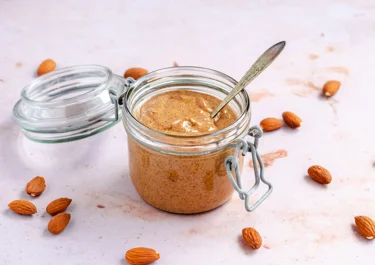
Almond butter

Instructions
Questions about almond butter
Making this recipe is both rewarding and delicious. Here, we address common questions and provide helpful tips to ensure you achieve the perfect homemade almond butter every time.
Ingredients
Almonds, raw | 300 g |
|---|---|
Fine sea salt | 1 pinch |
Cinnamon, ground cardamom or vanilla powder (to taste) |
Quick fixes for a too thick or dry almond butter
If your almond butter is too thick or dry, adding a small amount of warm water can help achieve the desired consistency. Start with a teaspoon and blend thoroughly, adding more if needed. Always ensure you blend well after each addition to maintain a smooth texture.
Master the art of almond roasting
Mastering the art of almond roasting is key to making delicious almond butter with a rich, deep flavour. Start by spreading raw almonds in a single layer on a baking sheet to ensure even roasting.
Stir them occasionally to prevent burning and promote uniform browning. Always keep a close eye on them, as nuts can quickly go from perfectly roasted to overly charred.
Once they turn a golden brown and release a fragrant aroma, remove them from the oven and let them cool completely. Roasting enhances the almonds' natural oils, making your almond butter smoother, more flavourful, and easier to blend.
Almond selection for a smooth almond butter
For the best results, choose high-quality raw almonds. Raw almonds allow you to control the roasting process, ensuring optimal flavour and texture. Look for uniform-sized nuts, as they roast more evenly. Freshness is also important; stale almonds can affect the taste of your almond butter. If you prefer a richer flavour, lightly roast the almonds before blending. Avoid pre-roasted or salted almonds, as they can alter the final spread’s taste and texture.
Take your time when blending the almonds
Patience is crucial when making almond butter. Initially, the almonds will turn into a fine flour. As you continue blending, they will clump together before eventually releasing their oils and transforming into smooth almond butter.
This process can take 10-15 minutes. Be sure to scrape down the sides of the food processor periodically to ensure even blending. Rushing this process or adding liquids too early can result in a grainy texture.
Lesser-known preparation techniques
For an extra depth of flavour, try soaking the almonds in salted water overnight before roasting them; this enhances their natural sweetness and adds a subtle savoury note. Additionally, you can experiment with sprouting the almonds by soaking them for 12 hours, draining, and then allowing them to sit in a jar with a mesh cover for another day or two until tiny sprouts appear.
Sprouted almonds offer a unique, slightly earthy flavour. These small adjustments can transform your almond butter into a gourmet delight, perfect for both sweet and savoury dishes.










